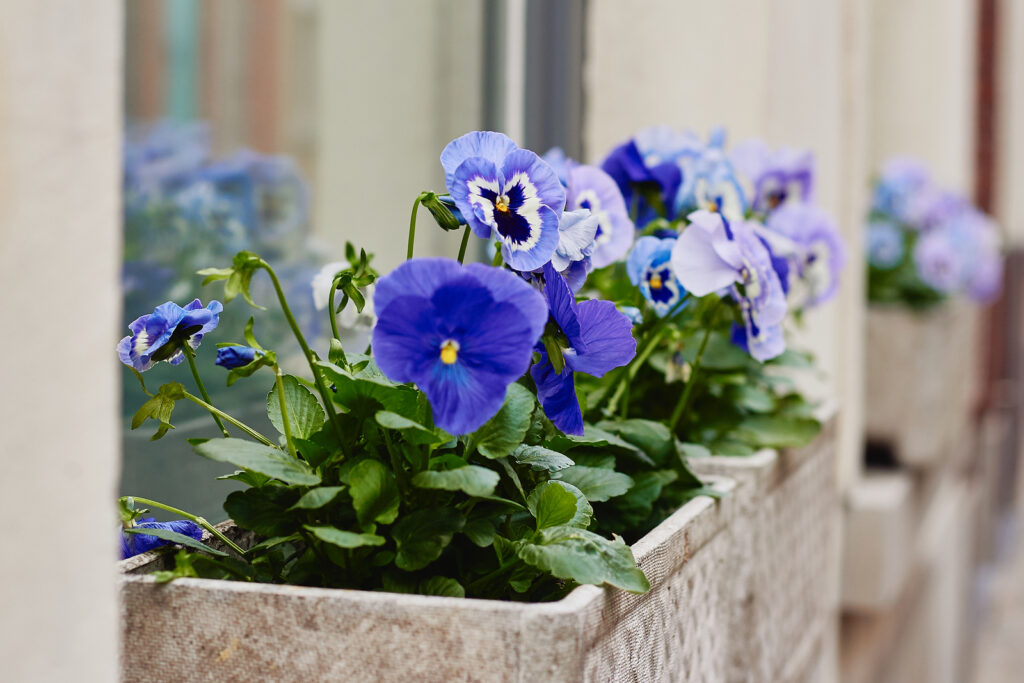Many annual and perennial flowers are well suited for growing in containers. Even some smaller shrubs and trees can be grown in containers.
Bloom, foliage color, and form should be top considerations when choosing plants for growing in pots, window boxes, or other containers.
Length of bloom and ability to withstand periodic and sometimes erratic watering are also important considerations.
Just as there are seasons in the garden, there are seasons in container gardens. Choose plants that flower in the seasons you will be closest to your container garden—whether it’s summer on the patio or winter in the sunroom.

Choosing plants for containers
A satisfying container flower design should include:
- Blooms that last for several weeks or longer.
- Foliage is attractive and interesting for months at a time.
- The overall form is suitable for a container.
- Roots that don’t mind being crowded.
- Moderate drought tolerance should the container go dry.
- Plant size to scale of the container.
Solo plant in containers
A single plant growing alone in a container can have an impact and make a design statement. Choose plants that are full, healthy, and colorful—either blooms or colorful foliage
Choose plants that will grow in scale with the container. Small pots want small plants; large pots want large plants. Look at plant labels or descriptions to know the size of the plant at maturity; put that plant in a pot that can accommodate that size.

Combining plants in containers
Combining flowering plants in a container requires just a tad of design sense. Here’s an easy rule of thumb for combining plants in a container: plant at least three different plants—one tall and spiky, one low and trailing, and one of medium height to fill between the tall and short one.
Follow a color scheme when combining blooming plants. Use a color wheel to make good choices—choose flowers that are either complementary or contrasting. Complementary colors are close to each other on the color wheel; contrasting colors are opposite each other on the color wheel.
Foliage color, texture, and size should also be considered. Again, use the color wheel when looking at foliage color. Choose plants with foliage sizes, shapes, and textures that are either complementary or contrasting as well.
Always consider each plant’s size at maturity when combining plants in a container. Make sure there is enough room for the full size and root growth of each plant.
Always consider the sunlight and water needs of each plant used in combination; all sun plants, all shade plants, plants that need little to moderate water, plants that need lots of water.

Container planting basics
Keep the following in mind when planting in containers:
- Use high-quality potting soil; don’t use regular garden soil.
- Make sure the pots are clean; used pots should be cleaned with a solution of water and a dash of chlorine bleach.
- Make sure pots have drainage holes.
- Moisten the potting soil ahead of planting.
- Loosen plant root balls when planting.
- Firm the soil in around the roots and water again.
Plants for containers
Here are some plants to get you started container flower gardening:
Tall flowers for containers
| Common Name | Botanical Name |
| Bells of Ireland | Moluccella laevis |
| Celosia | Celosia spp. |
| Canna | Canna hybrids |
| Delphinium | Delphinium elatum |
| Flax, New Zealand | Phormium spp. |
| Flowering tobacco | Nicotiana spp. |
| Salvia, annual blue | Salvia farinacea |
| Snapdragon | Antirrhinum majus |
| Spider flower | Cleome hassleriana |
Medium height flowers for containers
| Common Name | Botanical Name |
| Ageratum | Ageratum houstonianum |
| Begonia, various | Begonia spp. |
| Dusty miller | Senecio cineraria |
| Flowering cabbage, kale | Brassica oleracea |
| Geranium, upright types | Pelargonium spp. |
| Globe amaranth | Gomphrena globosa |
| Grasses | Various |
| Heliotrope | Heliotropium arborescens |
| Impatiens | Impatiens spp. |
| Marigold | Tagetes spp. |
| Pansy | Viola spp. |
| Tuberous begonia | Begonia x tuberhybrida |
| Vinca, annual | Catharanthus roseus |
| Wishbone, flower | Torenia fournieri |
| Zinnia | Zinnia spp. |
Low, trailing flowers for containers
| Common Name | Botanical Name |
| Dahlberg, daisy | Thymophylla tenuiloba |
| Edging lobelia | Lobelia erinus |
| Fan flower | Scaveola aemula |
| Fuchsia | Fuchsia spp. |
| Geranium, ivy type | Pelargonium spp. |
| Ivy | Various |
| Lantana | Lantana camara |
| Licorice plant | Helichrysum petiolare |
| Nasturtium | Trapaeolum majus |
| Petunia | Petunia spp. |
| Swan River daisy | Brachycome iberidifolia |
| Sweet alyssum | Lobularia maritima |
| Sweet pea | Lathyrus odoratus |
| Sweet potato vine | Ipomea batatas |
| Verbena, trailing forms | Verbena spp. |
Drought-tolerant plants for containers
| Common Name | Botanical Name |
| Agapanthus | Agapanthus spp. |
| Artemisia | Artemisia spp. |
| Cactus | Various |
| Dusty miller | Senecio cineraria |
| Geranium, annual | Pelargonium spp. |
| Flax, New Zealand | Phormium spp. |
| Hens and chicks | Sempervivum spp. |
| Kalanchoe | Kalanchoe |
| Lantana | Lantana spp. |
| Licorice plant | Helichrysum petiolare |
| Moss rose | Portulaca spp. |
| Salvia, annual blue | Salvia farinacea |
| Sedum, various | Sedum spp. |
| Thyme | Thymus spp. |
| Verbena | Verbena spp. |
| Yucca | Yucca filamentosa |















